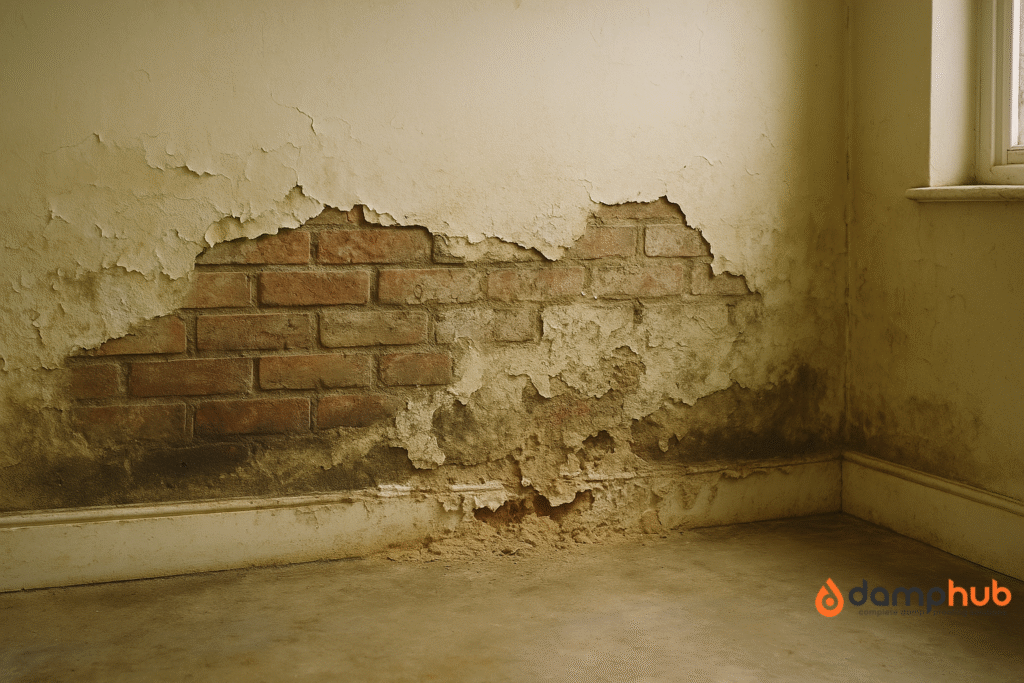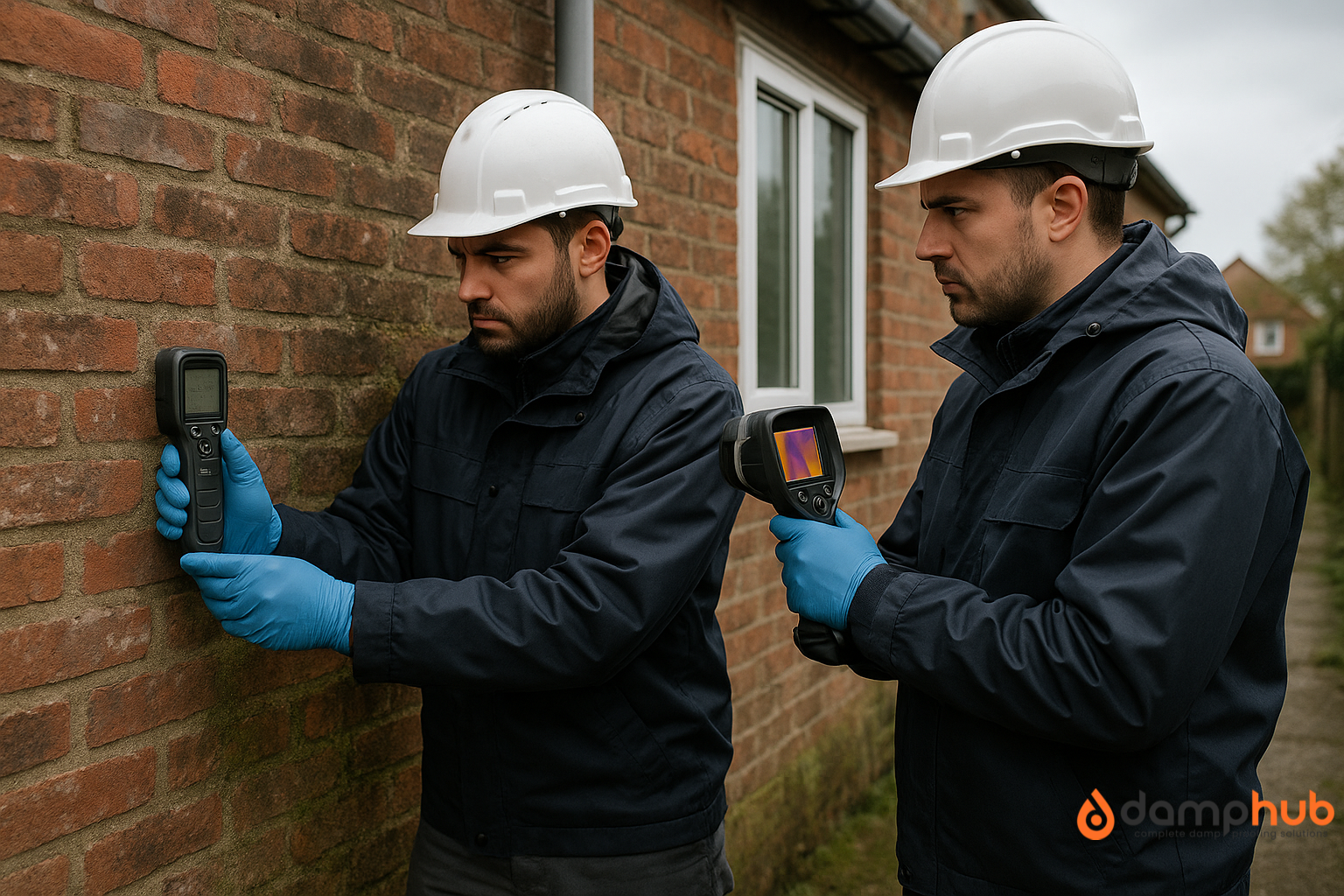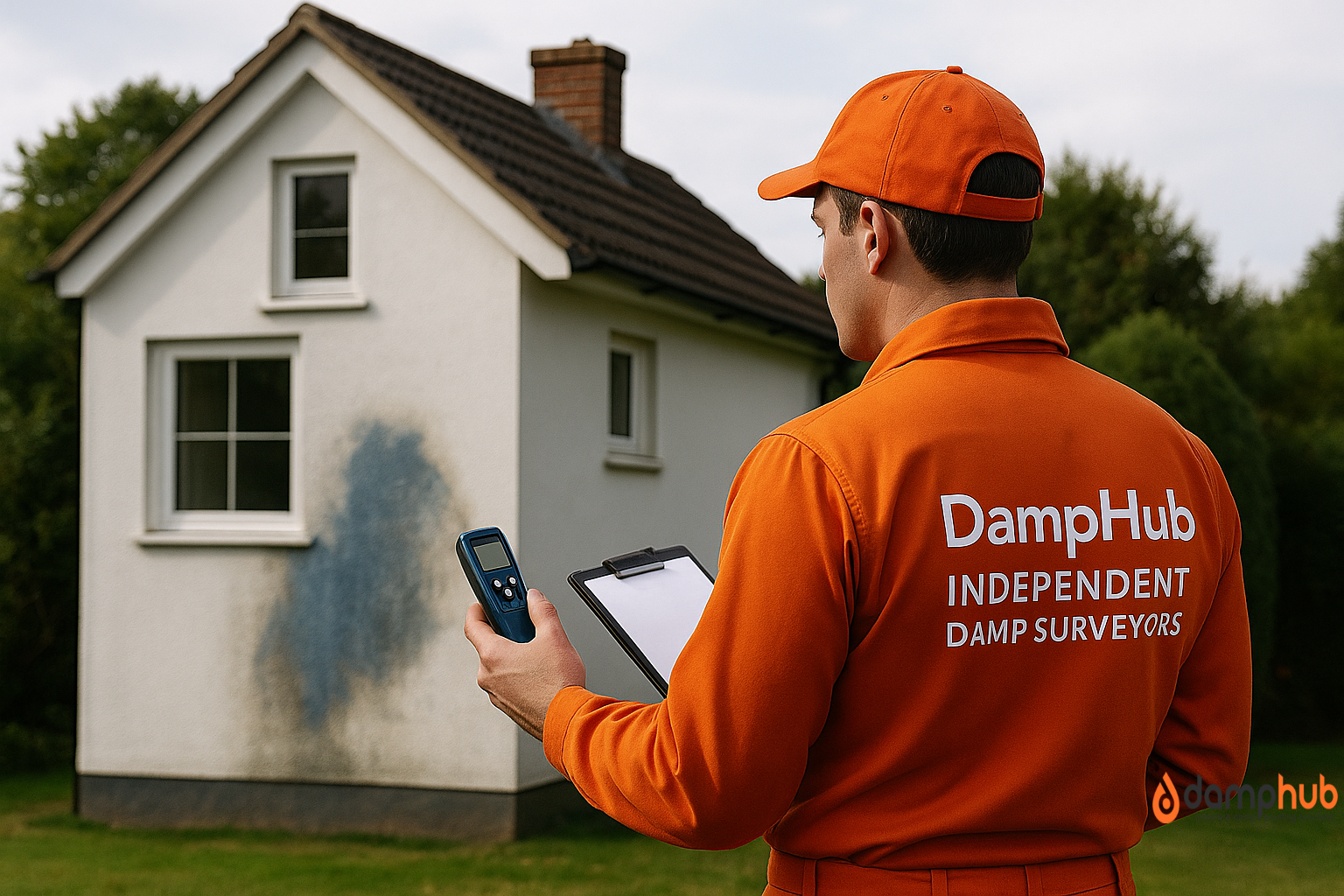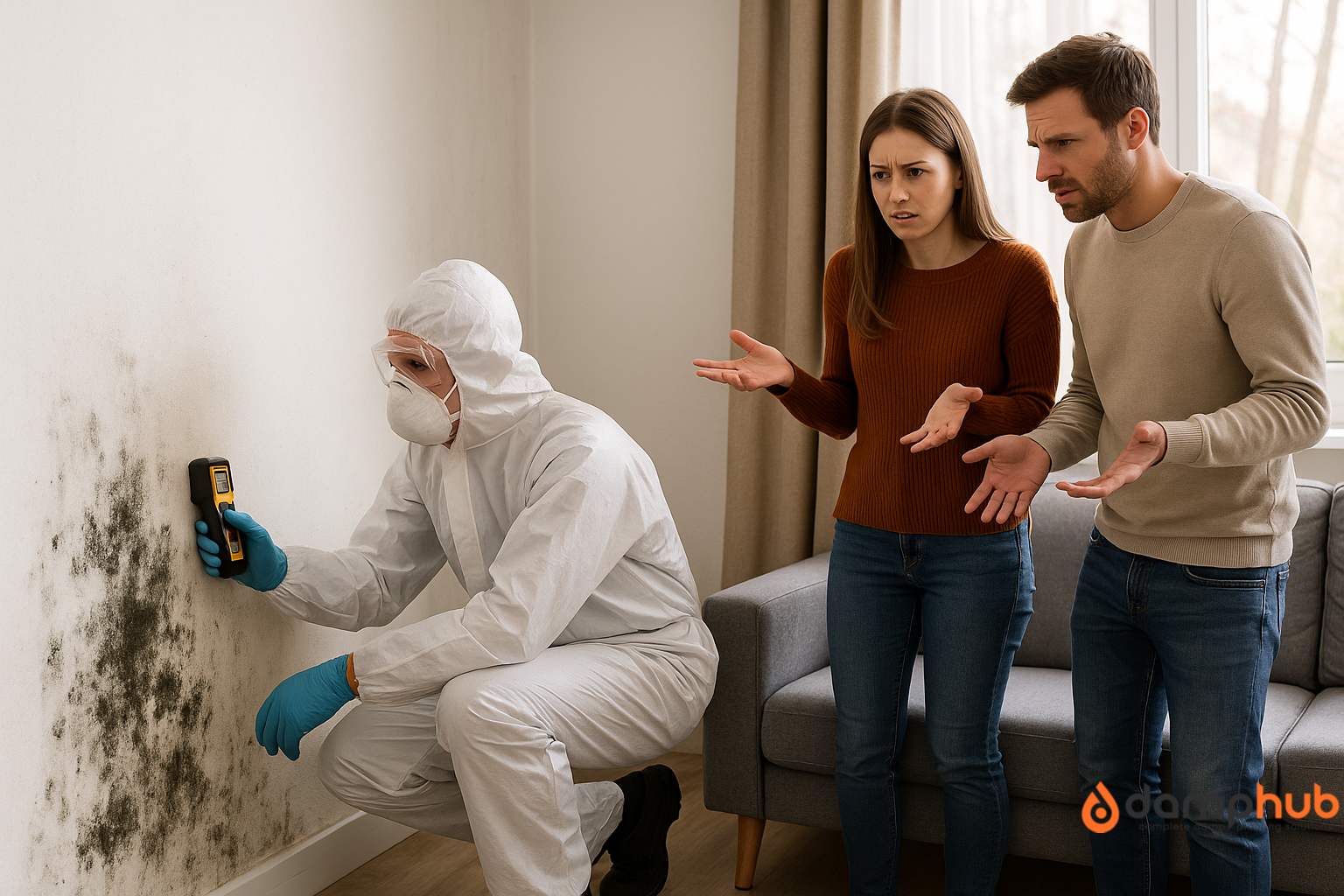
Ever walked into a room and thought, “Why does it smell like a wet towel in here?”
That’s probably damp. If you’ve seen paint bubbling, little black spots creeping up the wall, or your floors feel weirdly cold, that’s likely damp too, and you need a damp survey.
So, what is a damp survey exactly?
It’s a professional inspection of your property to identify signs of excess moisture, where it’s coming from, and how serious it is.
A damp surveyor near me uses specialist tools to detect hidden damp, assess the extent of the damage, and recommend the right treatment—before things get worse.
They’ll check things out properly, figure out what’s really going on behind the scenes, and explain what needs fixing. Not guesses. Not wishful thinking. Just straightforward answers.
And no—it’s not just some formality. These surveys can stop you from throwing thousands down the drain or watching your home quietly fall apart from the inside.
👉 Must Read: What is included in a Damp Survey?
The Usual Suspects: Types of Damp
1. Rising Damp
Rising damp seeps in from below, working its way up your walls. You’ll usually spot it messing with paint near the skirting or making plaster flake off. It’s slow, but it spreads.

2. Penetrating Damp
This comes through the walls. Rain gets into cracks or gaps in brickwork and just strolls in like it pays rent. Look out for random wet patches, especially after storms.
3. Condensation
This one’s common—and sneaky. It builds up from cooking, showering, or just breathing in the colder months. When warm air hits a cold wall, it turns into water. And mould loves that stuff.
Why You Should Get a Damp Survey
It’s Cheaper Than Waiting for the Walls to Rot
Leave damp alone, and it doesn’t just sit there—it gets worse. Think blown plaster, dry rot, buckled floors, and surprise repair bills. A proper surveyor near me helps you catch it early and fix it smart, before things spiral.
It’s Not Just About Appearance
Black mould doesn’t just look gross—it can mess with your health. If anyone in your home has asthma, allergies, or even just a dodgy immune system, it’s worth getting on top of the issue fast. A damp survey helps you make your home feel safe and dry again.
👉 Must Read: Is It Worth Paying for a Damp Survey?
It Can Affect House Value
If you’re selling, a damp report that shows your house is in good shape puts buyers at ease. And if you’re buying? A survey can reveal hidden problems before you sign anything—and give you ammo to knock the price down.
What Happens During a Damp Survey?
A decent surveyor won’t just peek around and shrug. They’re there to investigate properly, and they’ve got the kit to back it up.
They’ll usually check for:
- Visible signs like stains, mould, or flaky plaster
- Moisture readings inside the walls and floors using a moisture meter
- Cold spots with thermal imaging (to find hidden wet patches)
- Salt tests to work out where the water’s coming from
- And just plain experience—some can smell damp from the hallway

A good damp surveyor near me explain what they’re seeing as they go, and at the end, they’ll give you a written report that breaks down:
- What kind of damp is it
- Where it’s showing up
- What’s causing it
- What needs to happen next
- Plus, a rough idea of what it might cost to fix
That way, you’re not left guessing.
How Long Does A Damp Survey Take?
Most surveys take between three to four hours. If you’ve got a big property or serious issues, it might take longer. Reports are usually ready within a few days—some places offer a 24-hour turnaround if you’re in a hurry.
For a full cost breakdown, read: How Long Does a Damp Survey Take? A Step-by-Step Timeline
How Much Does a Damp Survey Cost?
It varies depending on the size of your place and who you hire, but here’s a general guide:
- Small flat: £150–£250
- 2–3 bed house: £300–£500
- Larger homes: £600+
Some companies offer free surveys, but here’s the catch: those are often sales calls in disguise. A paid, independent survey is far more reliable. No pressure, just the facts.
How to Pick the Right Damp Surveyor
Not all surveyors are the same. Look out for the ones who:
- Work independently (not trying to sell treatments)
- Explain things clearly (no jargon or waffle)
- Provide detailed reports (more than just a one-pager)
- Have strong reviews (check Google, Checkatrade, or Trustpilot)
Quick tip: Ask to see a sample report before booking. If it’s neat, clear, and informative, that’s a good sign.
Signs You Might Need a Damp Survey
Still on the fence? These red flags usually mean it’s time to get someone in:
- Peeling or bubbling paint
- Musty smells that won’t go away
- Mould on walls or ceilings
- Watermarks or tide marks on plaster
- Cold patches on walls, even with the heating on
- Excessive condensation on windows in the morning
If any of those sound familiar, don’t wait around. Damp doesn’t fix itself.

Can You Check for Damp Yourself?
Sort of. You can spot warning signs, but you won’t know the cause or the scale.
Still, here are a few things you can do:
- Feel the walls—do they seem damp or colder than the rest?
- Look behind heavy furniture—mould loves quiet corners
- Check the gutters—blocked ones can soak the external walls
- Buy a humidity meter—anything above 60% might mean trouble
These DIY checks help, but they won’t replace a proper survey. You won’t know how deep the damage goes without expert tools, so you’d better hire a damp surveyor near me.
👉 Must Read: 10 Best Damp Survey Companies in London
What Happens After the Survey?
So, you’ve got the report—what now?
- Read it properly. Don’t just skim it. Understand what type of damp you’re dealing with.
- Get a few quotes. If repairs are needed, don’t jump on the first offer. Get two or three for comparison.
- Fix the root cause. Don’t just treat the wall if a leaky pipe or dodgy ventilation is the real culprit.
- Keep an eye on things. Once fixed, keep checking during wet seasons to make sure it doesn’t creep back.
How to Prevent Damp in Future
Once the issue’s sorted, here’s how to avoid round two:
- Clear gutters and downpipes regularly
- Open windows after showers or cooking
- Use extractor fans in kitchens and bathrooms
- Don’t block air vents or bricks
- Fix leaks straight away—don’t put it off
- Avoid drying clothes indoors without ventilation or a dehumidifier
Small habits like these make a huge difference.
👉 Must Read: How to Hire an Independent Damp Specialist in London
Final Word: What is A Damp Survey
A damp survey isn’t just some box to tick. It’s a solid step towards protecting your home, your health, and your bank balance.
Whether you’re noticing that weird damp smell, buying a house, or just being proactive, getting the place checked out properly is well worth it.
Because let’s face it: no one wants to discover black mould crawling up the wall after it’s already done the damage.
What Is a Damp Survey? Common Questions Answered
How long does a damp survey report take?
Most reports are delivered within 24 to 72 hours after the inspection.
Independent surveyors may take longer if detailed analysis is needed.
Some companies offer next-day reports, especially in urgent sales or rental cases.
What to expect from a damp survey?
Expect a full inspection of affected areas, including moisture readings, visual checks, and thermal imaging.
The surveyor will explain findings and provide a written report that covers the type of damp, its cause, affected areas, and recommended treatments.
How is a damp test done?
A damp test uses tools like moisture meters to measure wall and floor moisture levels. Thermal imaging may reveal hidden damp.
Salt testing helps identify rising damp. The surveyor interprets results based on readings, patterns, and building materials.
What do they do on a damp survey?
The surveyor inspects for signs of damp, takes moisture readings, checks ventilation, and looks at possible external causes like blocked gutters or cracked walls. Findings are used to diagnose the damp type and suggest next steps.
How much does it cost for a damp survey?
Costs vary by property size and location. Expect to pay £150–£250 for a flat, £300–£500 for a typical house, and £600+ for large properties.
Independent surveys offer unbiased advice but may cost more than sales-driven “free” surveys.
What to do before a damp survey?
Clear access to walls, corners, and behind furniture. Avoid covering stains or using dehumidifiers to hide signs.
Gather any history of leaks or previous damp problems. Proper access helps the surveyor make an accurate assessment.
Who pays for a damp survey?
The person who orders the survey pays. Homeowners, buyers, and landlords commonly pay for inspections.
In rental situations, landlords are usually responsible if damp affects living conditions or tenant health.
How to test if your house is damp?
Look for signs like musty smells, mould, water stains, peeling paint, or condensation on windows.
Use a handheld moisture meter for basic testing. Check behind furniture and in cold corners. For accurate results, book a professional damp survey.
What to do if a surveyor finds damp?
Review the report carefully. Fix the root cause—such as leaks or poor ventilation—before cosmetic repairs.
Get multiple quotes for treatment. If you’re a tenant, notify your landlord with written proof. Early action prevents structural damage and health risks.






